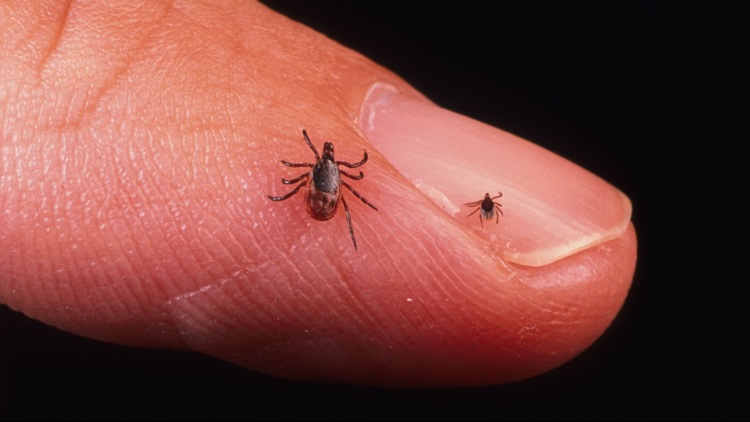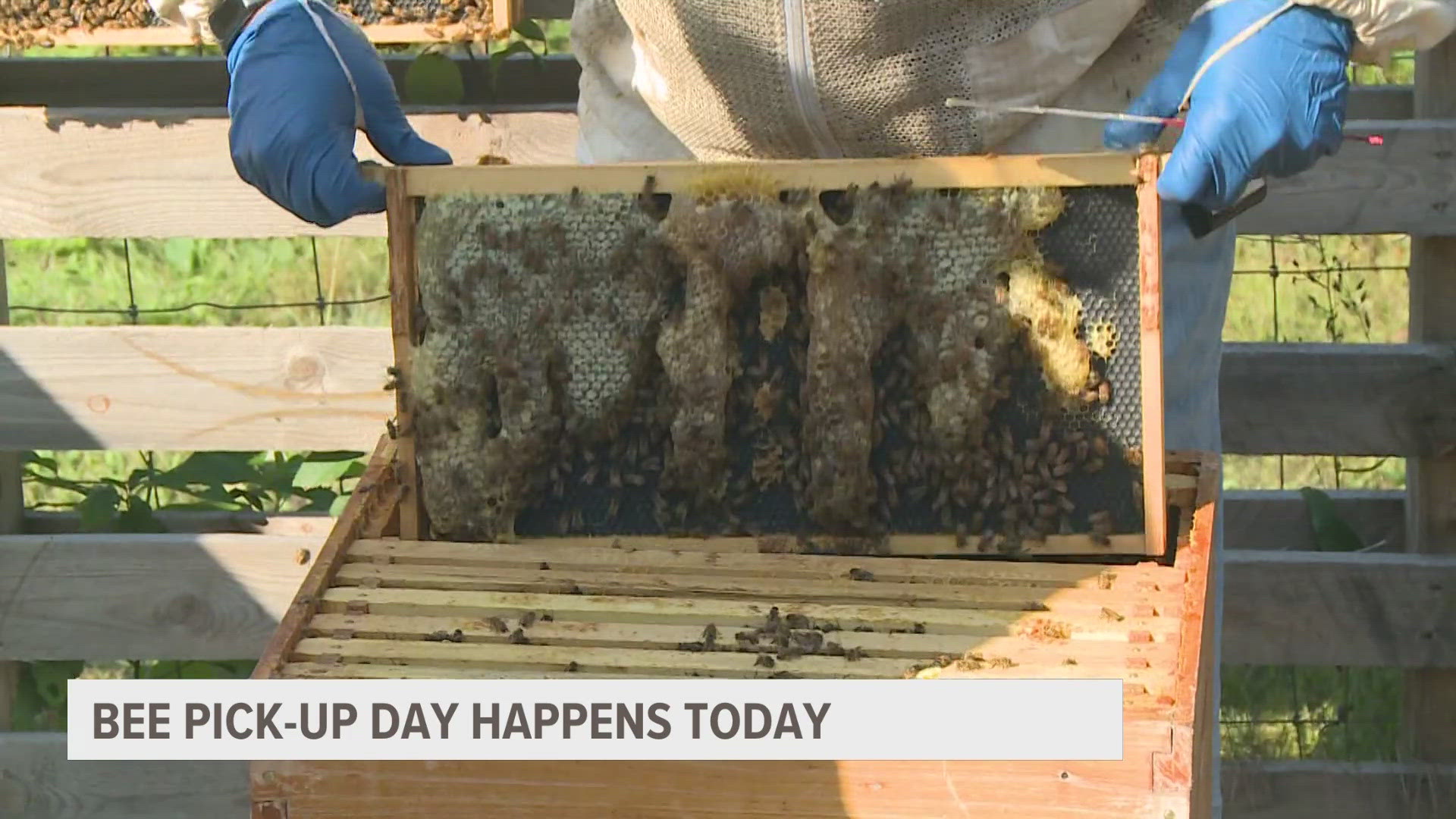It's the time of year when the creepy crawlies come out to feast upon our blood. But, you shouldn't let the threat of a mosquito or tick bite keep you from enjoying the out-of-doors.
Ticks are being found right now in West Michigan, and Lyme disease is a concern for many people. There is even a disease that is spread by the lone star tick that can make you allergic to red meat.
But prevention is key in avoiding the diseases that are spread by tick bites. And there are steps you can take to avoid picking up ticks in the first place that have been shared by the Centers for Disease Control and Prevention.
Preventing tick bites
Tick exposure can occur year-round, but ticks are most active during warmer months (April-September). Know which ticks are most common in your area.
- Know where to expect ticks. Ticks live in grassy, brushy, or wooded areas, or even on animals. Spending time outside walking your dog, camping, gardening, or hunting could bring you in close contact with ticks. Many people get ticks in their own yard or neighborhood.
- Treat clothing and gear with products containing 0.5% permethrin. Permethrin can be used to treat boots, clothing and camping gear and remain protective through several washings. Alternatively, you can buy permethrin-treated clothing and gear.
- Use Environmental Protection Agency (EPA)-registered insect repellents containing DEET, picaridin, IR3535, Oil of Lemon Eucalyptus (OLE), para-menthane-diol (PMD), or 2-undecanone. EPA’s helpful search tool can help you find the product that best suits your needs. Always follow product instructions.
- Do not use insect repellent on babies younger than 2 months old.
- Do not use products containing OLE or PMD on children under 3 years old.
- Avoid Contact with Ticks
- Avoid wooded and brushy areas with high grass and leaf litter.
- Walk in the center of trails.
Check your clothing for ticks. Ticks may be carried into the house on clothing. Any ticks that are found should be removed. Tumble dry clothes in a dryer on high heat for 10 minutes to kill ticks on dry clothing after you come indoors. If the clothes are damp, additional time may be needed. If the clothes require washing first, hot water is recommended. Cold and medium temperature water will not kill ticks.
Examine gear and pets. Ticks can ride into the home on clothing and pets, then attach to a person later, so carefully examine pets, coats, and daypacks.
Shower soon after being outdoors. Showering within two hours of coming indoors has been shown to reduce your risk of getting Lyme disease and may be effective in reducing the risk of other tickborne diseases. Showering may help wash off unattached ticks and it is a good opportunity to do a tick check.
Check your body for ticks after being outdoors. Conduct a full body check upon return from potentially tick-infested areas, including your own backyard. Use a hand-held or full-length mirror to view all parts of your body. Check these parts of your body and your child’s body for ticks:
- Under the arms
- In and around the ears
- Inside belly button
- Back of the knees
- In and around the hair
- Between the legs
- Around the waist
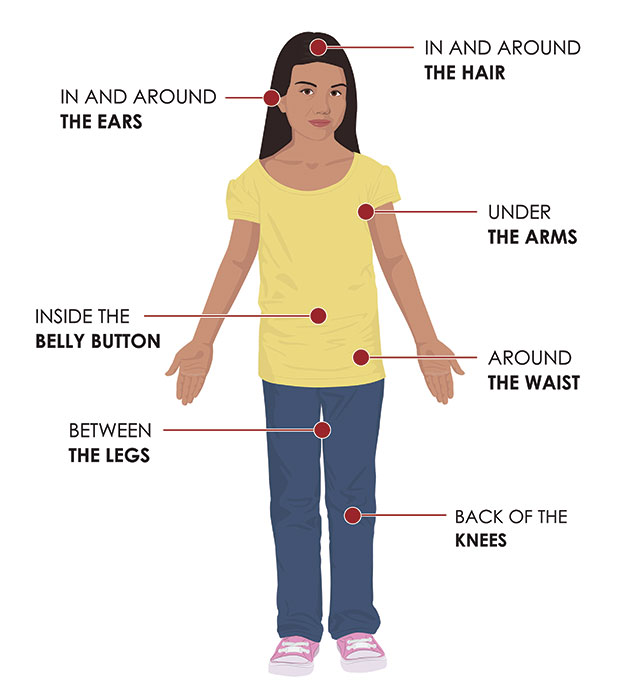
Remove Attached Ticks Quickly and Correctly

Remove an attached tick with fine-tipped tweezers as soon as you notice it. If a tick is attached to your skin for less than 24 hours, your chance of getting Lyme disease is extremely small; however, other diseases may be transmitted more quickly.
Over the next few weeks, watch for signs or symptoms of Lyme disease such as rash or fever. See a healthcare provider if you have signs or symptoms. For more information, see tick removal.
Be Alert for Fever or Rash
Even if you don’t remember being bitten by a tick, an unexpected summer fever or odd rash may be the first signs of Lyme disease, particularly if you’ve been in tick habitat. See your healthcare provider if you have symptoms.
Know Your Ticks

BLACKLEGGED TICK Ixodes scapularis
WHERE FOUND Widely distributed across the eastern United States.
TRANSMITS Borrelia burgdorferi and B. mayonii (which cause Lyme disease), Anaplasma phagocytophilum (anaplasmosis), B. miyamotoi disease (a form of relapsing fever), Ehrlichia muris eauclairensis (ehrlichiosis), Babesia microti (babesiosis), and Powassan virus (Powassan virus disease).
COMMENTS The greatest risk of being bitten exists in the spring, summer, and fall in the Northeast, Upper Midwest and mid-Atlantic. However, adult ticks may be out searching for a host any time winter temperatures are above freezing. All life stages bite humans, but nymphs and adult females are most commonly found on people.
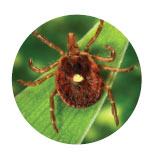
LONE STAR TICK Amblyomma americanum
WHERE FOUND Widely distributed in the eastern United States, but more common in the South.
TRANSMITS Ehrlichia chaffeensis and E. ewingii (which cause human ehrlichiosis), Francisella tularensis (tularemia), Heartland virus (Heartland virus disease), Bourbon virus (Bourbon virus disease), and Southern tick-associated rash illness (STARI).
COMMENTS The greatest risk of being bitten exists in early spring through late fall. A very aggressive tick that bites humans. The adult female is distinguished by a white dot or “lone star” on her back. The nymph and adult females most frequently bite humans.
Allergic reactions associated with consumption of red (mammalian) meat have been reported among persons bitten by lone star ticks.
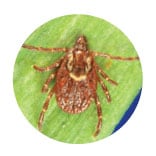
AMERICAN DOG TICK Dermacentor variabilis
WHERE FOUND Widely distributed east of the Rocky Mountains. Also occurs in limited areas on the Pacific Coast.
TRANSMITS Francisella tularensis (tularemia) and Rickettsia rickettsii (Rocky Mountain spotted fever).
COMMENTS The greatest risk of being bitten occurs during spring and summer. Adult females are most likely to bite humans.
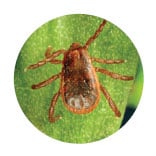
BROWN DOG TICK Rhipicephalus sanguineus
WHERE FOUND Worldwide.
TRANSMITS Rickettsia rickettsii (Rocky Mountain spotted fever). Primary vector for R. rickettsiitransmission in the southwestern United States and along the U.S.-Mexico border.
COMMENTS Dogs are the primary host for the brown dog tick in each of its life stages, but the tick may also bite humans or other mammals.
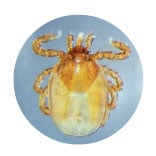
GROUNDHOG TICK Ixodes cookei
WHERE FOUND Throughout the eastern half of the United States.
TRANSMITS Powassan virus (Powassan virus disease).
COMMENTS Also called woodchuck ticks. All life stages feed on a variety of warm-blooded animals, including groundhogs, skunks, squirrels, raccoons, foxes, weasels, and occasionally people and domestic animals. Photo courtesy of Steve Jacobs, PSU Entomology.
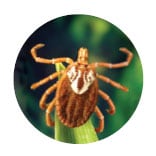
GULF COAST TICK Amblyomma maculatum
WHERE FOUND Southeastern and mid-Atlantic states and southern Arizona.
TRANSMITS R. parkeri (R. parkeri rickettsiosis), a form of spotted fever.
COMMENTS Larvae and nymphs feed on birds and small rodents, while adult ticks feed on deer and other wildlife. Adult ticks have been associated with transmission of R. parkeri to humans.
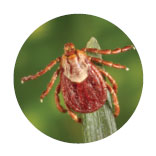
ROCKY MOUNTAIN WOOD TICK Dermacentor andersoni
WHERE FOUND Rocky Mountain states.
TRANSMITS Rickettsia rickettsii (Rocky Mountain spotted fever), Colorado tick fever virus (Colorado tick fever), and Francisella tularensis (tularemia).
COMMENTS Adult ticks feed primarily on large mammals. Larvae and nymphs feed on small rodents. Adult ticks are primarily associated with pathogen transmission to humans.
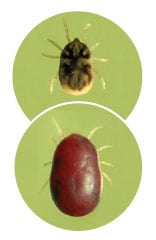
SOFT TICK Ornithodoros spp.
WHERE FOUND Throughout the western half of the United States, including Texas.
TRANSMITS Borrelia hermsii, B. turicatae (tick-borne relapsing fever [TBRF]).
COMMENTS Humans typically come into contact with soft ticks in rustic cabins. The ticks emerge at night and feed briefly while people are sleeping. Most people are unaware that they have been bitten. In Texas, TBRF may be associated with cave exposure.
O. hermsi tick, before and after feeding. Photo taken by Gary Hettrick RML, NIAID.
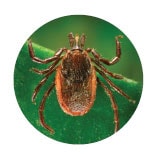
WESTERN BLACKLEGGED TICK Ixodes pacificus
WHERE FOUND In the Pacific Coast states.
TRANSMITS Anaplasma phagocytophilum (anaplasmosis), B. burgdorferi (Lyme disease), and very likely B. miyamotoi (Borrelia miyamotoi disease, a form of relapsing fever).
COMMENTS Larvae and nymphs often feed on lizards, birds, and rodents, and adults more commonly feed on deer. Although all life stages bite humans, nymphs and adult females are more often reported on humans.
Ticks That Commonly Bite Humans
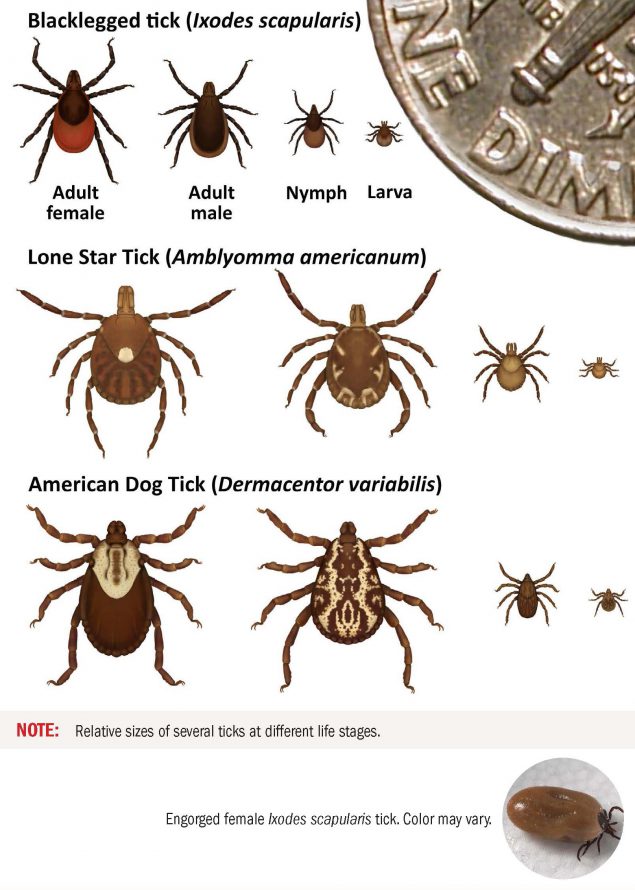
Related videos:
How to protect your pets form ticks this season
Watch out for ticks this summer!
►Make it easy to keep up to date with more stories like this. Download the 13 ON YOUR SIDE app now.
Have a news tip? Email news@13onyourside.com, visit our Facebook page or Twitter.


